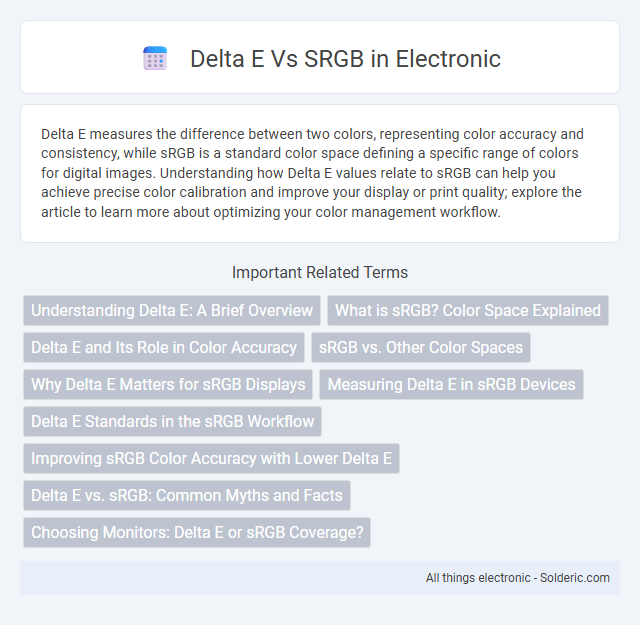Delta E measures the difference between two colors, representing color accuracy and consistency, while sRGB is a standard color space defining a specific range of colors for digital images. Understanding how Delta E values relate to sRGB can help you achieve precise color calibration and improve your display or print quality; explore the article to learn more about optimizing your color management workflow.
Comparison Table
| Feature | Delta E | sRGB |
|---|---|---|
| Definition | Metric for color difference accuracy between two colors | Standard RGB color space for digital images and displays |
| Purpose | Quantifies perceived color difference measurement | Defines color gamut and color profiles |
| Unit | Delta E (DE) value (numeric difference) | Color coordinate values within RGB range |
| Usage | Color calibration, quality control in printing, imaging | Standard for web, monitors, digital cameras |
| Range | 0 (no difference) to higher values indicating visible difference | Defined color gamut covering ~35% of visible spectrum |
| Measurement Basis | CIELAB or CIEDE2000 color spaces for perceptual uniformity | RGB primaries and gamma curve standardized by IEC 61966-2-1 |
Understanding Delta E: A Brief Overview
Delta E quantifies the difference between two colors as perceived by the human eye, serving as a crucial metric in color accuracy and quality control. sRGB, a standard color space for digital images, relies on precise color matching where minimizing Delta E values ensures faithful color reproduction. Accurate Delta E measurements facilitate consistent color representation across devices and media, critical for professionals working in digital imaging and printing industries.
What is sRGB? Color Space Explained
sRGB is a standardized color space developed by HP and Microsoft in 1996, designed to represent the typical colors displayed on monitors, printers, and the internet. It defines a specific range of colors using Red, Green, and Blue primaries aligned to a standard gamma curve, enabling consistent color reproduction across different devices. The Delta E value measures the perceptual difference between colors within the sRGB gamut, indicating accuracy and fidelity in color matching.
Delta E and Its Role in Color Accuracy
Delta E quantifies color differences by measuring the deviation between a displayed color and its reference standard, playing a critical role in color accuracy evaluation. Lower Delta E values signify higher fidelity, with values below 1 typically imperceptible to the human eye and those under 3 considered acceptable for most professional applications involving sRGB color spaces. Understanding Delta E helps you ensure precise color reproduction, essential for industries like digital imaging, printing, and display manufacturing where accurate sRGB color representation is crucial.
sRGB vs. Other Color Spaces
sRGB is a standardized color space widely used for digital imaging, characterized by a relatively narrow gamut compared to Adobe RGB or ProPhoto RGB, which offer broader color ranges for professional photography and print media. Delta E measures the perceptual difference between colors, with lower Delta E values in sRGB indicating closer color matching within its limited gamut versus other larger color spaces where color accuracy can vary significantly. Understanding the Delta E values across different color spaces helps optimize color reproduction accuracy, especially when converting images between sRGB and wider gamuts.
Why Delta E Matters for sRGB Displays
Delta E quantifies the difference between expected and displayed colors on sRGB monitors, ensuring color accuracy for digital content creation and viewing. Low Delta E values (typically below 2) indicate minimal color distortion, crucial for photographers, designers, and video editors relying on precise color representation. Accurate Delta E compliance enhances visual consistency across different devices, reducing discrepancies in color perception and improving overall user experience.
Measuring Delta E in sRGB Devices
Measuring Delta E in sRGB devices quantifies the perceptible color difference between intended and displayed colors, essential for color accuracy in digital imaging. Delta E values below 2 are generally imperceptible to the human eye, indicating precise color reproduction in sRGB monitors and printers. Tools like spectrophotometers and colorimeters assess Delta E by comparing the CIELAB color space coordinates, ensuring consistent, vibrant color performance within the sRGB color gamut.
Delta E Standards in the sRGB Workflow
Delta E standards in the sRGB workflow measure the color difference between the original and reproduced colors, ensuring accurate color representation across devices and media. A Delta E value below 1 is typically imperceptible to the human eye, while values up to 3 are considered acceptable for most professional applications. Understanding these thresholds helps you maintain color fidelity throughout the sRGB color space, critical for consistent digital imaging and printing outcomes.
Improving sRGB Color Accuracy with Lower Delta E
Lower Delta E values indicate more precise color reproduction within the sRGB color space, enhancing visual accuracy and consistency across devices. By minimizing Delta E, you achieve truer colors that closely match the original source, crucial for digital content creation and professional imaging. Improving sRGB color accuracy with reduced Delta E ensures your visuals maintain fidelity and vibrancy under standardized viewing conditions.
Delta E vs. sRGB: Common Myths and Facts
Delta E measures color difference accuracy, essential for evaluating sRGB color reproduction quality in digital displays and printing. A low Delta E value (below 2) indicates minimal color deviation from the sRGB standard, ensuring precise and true-to-life colors for your projects. Understanding that a higher Delta E does not always signify poor color quality debunks the myth that all deviations are visually unacceptable.
Choosing Monitors: Delta E or sRGB Coverage?
When choosing monitors for color-critical work, prioritizing Delta E values under 2 ensures accurate color reproduction, as lower Delta E indicates minimal color deviation. sRGB coverage percentage reflects the monitor's ability to display a wide range of colors within the sRGB color space, important for general digital content. For precise color fidelity, selecting monitors with both high sRGB coverage (close to 100%) and a low Delta E value guarantees the best color accuracy and consistency.
Delta E vs sRGB Infographic

 solderic.com
solderic.com